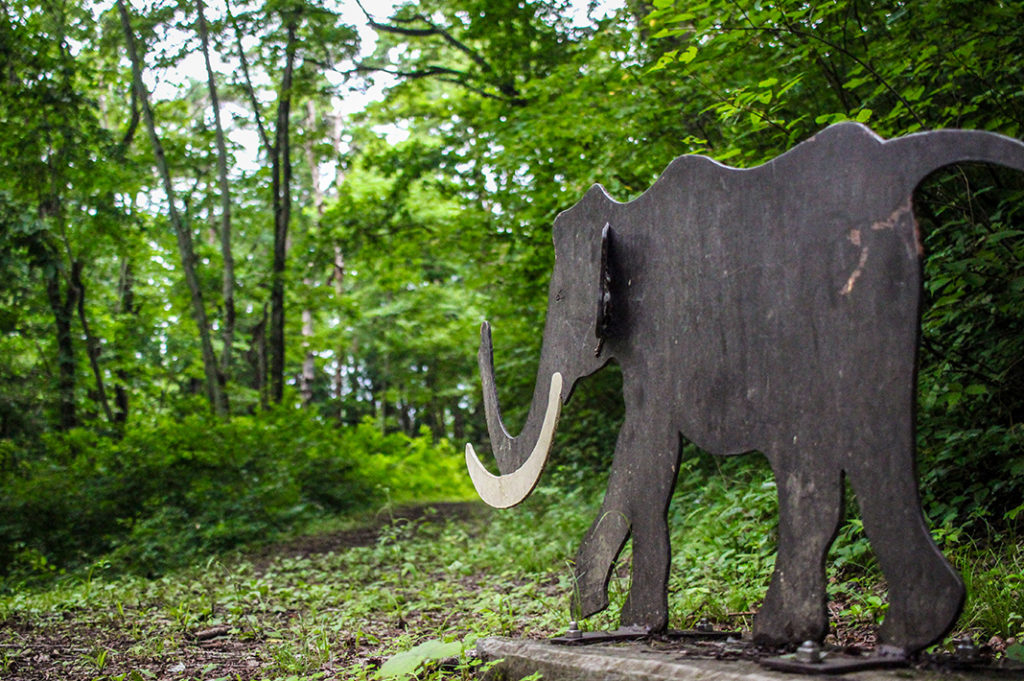
One of the best nature escapes on Japan’s main island of Honshu has got to be Lake Nojiri. Located high in the northern Nagano mountains, this ancient glacial lake is part of the Myoko Togakushi Renzan National Park. The local attractions all revolve around enjoying the pristine natural surroundings: snow sports in winter; kayaking, fishing and boating in the warmer months. For those partial to hiking and walking, the zo no komichi [elephant’s path] offers more than just exercise. This easy 2.5km trail winds through the forest along Lake Nojiri’s southern shoreline. With lake views, secluded canopies and a whole lot of ‘forest bathing’, you’ll be able to leave the real world behind and give in to the therapeutic benefits of the healing forest.
The Elephant Path is so-called because of the Naumann Elephant fossils and artefacts excavated from the lake over the past seventy years. Many of these are on display in town at the Nojiriko Naumann Elephant Museum which is a great place to start your walk. From the museum, follow signs for the Nojiri Loop Track and after about 30 minutes (2.4km), you’ll come across the entrance to the Zo No Komichi on your left.
Before you enter, take note of the painted map, as the path isn’t visible on Google Maps. For another reference, check out our map of key points.
Walking the zo no komichi
Walking through the forest during July is a Mononoke-esque experience. Everything is green and glistening and there is a constant high-pitched chatter echoing from the tree canopy. The network of birds and cicadas call to one another and it feels as though every eye is trained on you.
I lose count of the number of dewy mushrooms I see poking through the damp forest floor or growing over fallen logs. The wet pine trees give off the scent of Christmas and every now and then, a cool breeze blows over from the lake.
There is life everywhere on the zo no komichi, and this includes animal life. Minutes into my walk, I bump into someone coming the opposite direction who tells me she saw a bear the day before. Word has it that the lack of tourists during COVID-19 has inspired the bears to roam.
I continue on and my bear bell jingle-jangles, alerting my presence to any four (or more) legged locals. For a little while, every scurried movement in the underbrush, every crack of a twig, sends my heart racing. These responses are great for survival but not so helpful for a therapeutic forest bathing experience. Luckily, every so often, I come across a sign to help recenter my thoughts.
Signs to help you forest bathe
If you’re a pro at relaxing in nature, we applaud you. However, if you’re the type to charge through a hike, mind racing, barely taking in the sights, this next bit is essential reading. Here in Japan, the physiological effects of spending time in the forest have been studied, and this common past time is known as ‘forest bathing’. Along with places like the Akasawa Natural Recreational Forest, the Shinanomachi area is a leader in forest therapy research.
As such, the zo no komichi has helpful signs along the path offering tips on how to get the most out of your forest therapy experience. Each one instructs visitors on a different element: slowing down, breathing deep, stretching, meditating; all designed to help you absorb the atmosphere as well as the many theorised health benefits.
The idea is that the longer you immerse yourself in nature, the greater the benefits, so don’t rush through! Take in the lake views, enjoy the signs of life (and death) all around and bathe in the natural beauty and quiet energy of the national park. The guides say the trail is 2.5km each way, but my GPS suggests it’s closer to 4km. Regardless, set aside 2 hours to complete the trail (1 hour each way) to ensure you do it slowly and properly.
If you’re in the area longer, there are a few other great walks. The 7km Naena Falls course, the 1.2km Ojika Pond course or, if you’re feeling up to it, the 16km loop around the lake. This last one is a great way to acquaint yourself with the local environment and the small communities around the lake. We walked it in around 4 hours, but it would make for a great bike ride, too!
Getting to Lake Nojiri
As it takes around 3 hours to get to Nojiri from Tokyo, you’ll want to stay awhile. After all, what’s the point in travelling all that way to unwind if you need to leave so soon?
Lake Nojiri’s access point is Kurohime Station. From Tokyo, take the Hokuriku Shinkansen 90 minutes to Nagano, then switch to the ‘Shinano Tetsudo Kita-Shinano Line’ bound for Myoko Kogen (35 min). The one-way trip costs around 8,500yen. Once at Kurohime Station, it’s a 6-minute taxi or 45-minute walk to the lake, where most of the accommodation can be found.
Post by Japan Journeys.